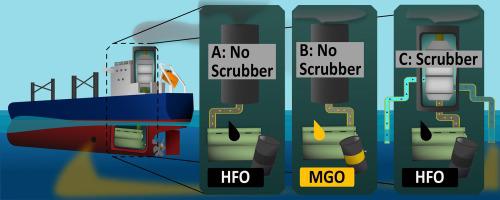Transportation Research Part D: Transport and Environment ( IF 7.3 ) Pub Date : 2021-06-05 , DOI: 10.1016/j.trd.2021.102912 Anna Lunde Hermansson , Ida-Maja Hassellöv , Jana Moldanová , Erik Ytreberg

|
In January 2020, new global regulations were implemented to limit the maximum sulphur content in marine fuels. As an alternative to switch to compliant fuels, the regulations allow for installations of exhaust gas cleaning systems, e.g. scrubbers, that enables a continued use of less expensive heavy fuel oils (HFOs). Characterization of scrubber discharge water shows that the acidified water also becomes enriched with contaminants, and large quantities of metals and polyaromatic hydrocarbons (PAHs) are thus being discharged directly to the marine environment. When emissions of contaminants to the atmosphere and the marine environment are evaluated simultaneously, the results show that HFO, with scrubbers installed, generates higher emission factors of both metals and PAHs compared to MGO. This highlights the importance of including both the marine and the atmospheric perspective when comparing environmental loads and impact of contaminants from shipping.
中文翻译:

比较来自船用燃料和洗涤器的多环芳烃和金属的排放
2020 年 1 月,实施了新的全球法规,以限制船用燃料中的最大硫含量。作为改用合规燃料的替代方案,法规允许安装废气净化系统,例如洗涤器,从而能够继续使用较便宜的重油 (HFO)。洗涤塔排放水的特征表明,酸化的水也变得富含污染物,因此大量金属和多环芳烃 (PAH) 直接排放到海洋环境中。当同时评估污染物向大气和海洋环境的排放时,结果表明,与 MGO 相比,安装了洗涤器的 HFO 会产生更高的金属和 PAH 排放因子。











































 京公网安备 11010802027423号
京公网安备 11010802027423号